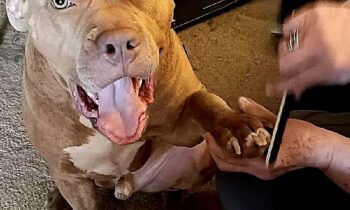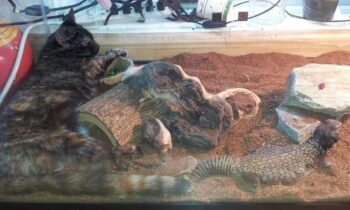Does your dog free-feed or does your dog eat on a fixed schedule of feeding times? Last week, dog owners discussed how they feed and why. They agreed that when and how a dog is fed can affect the dog’s health and behavior, possibly just as much as what a dog is fed. This week, I’ve asked dog professionals to explain the advice they give clients and friends about how and when to feed a dog.
Jessica Stinson Hudson When I was a child, my grandmother had a dog who was fed at 5 p.m. on the dot. God forbid someone forgot! At five o’clock the dog barked, bugged us, and ran to the pantry door and back letting us know what time it was. That was never appealing to me, and it didn’t seem healthy.
My dogs are not fed on a schedule. They could eat two or three times a day, all different times (my schedule is erratic), they could eat out of a regular bowl (especially on days that we’ve done lots of other training/brain games) puzzle toys, stuffed KONGs, scattered kibble, hand-feeding during training, etc. One thing that I’ve found is this has caused my dogs to be very adaptable. Since they aren’t on a set schedule, they didn’t freak out during the time change. They aren’t rattled if I get home late. They are also more motivated by meals and food, which gives me that motivator [to use in training]. I also generalize feeding areas—they think nothing of eating in the bathroom, off various surfaces, on a cot, out of novelty items, from different surfaces like grass/deck/in car/away from home. I like adaptability with my dogs and this is one way I’ve been able to get it.
On a slightly different note, my training clients who free-feed their dogs tend to have dogs who aren’t motivated by much. They have access all day, tend to pick and graze, and they don’t seem as motivated to interact with the owners because food has never been used outside of being poured into their bowls. Practically every single dog that a client says is not very motivated by food or treats is either free-fed or fed on a schedule, but [they] don’t usually finish the meals offered and they are allowed the option to eat or not. The dog doesn’t look to the owner for resources and doesn’t show much deference or seek guidance, which affects training opportunities.
Natalie Bridger Watson Yep. I just finished a month of intensive training with a family exactly like this and it felt like pulling teeth. The dog could have made ten times as much progress in that time if she wasn’t perpetually stuffed to the gills. The dog should have been 35 pounds and was probably pushing 50, while the owner lamented that the dog just wouldn’t eat.
Annie Zeck When I was in Spokane, I could have specialized in house-training small-breed dogs if I had wanted to (I didn’t). Many people fed kibble and their dogs drank water all day long. I asked them to try frozen raw and the dogs would get enough fluid that way. It got to the point that I would have them try that before I would schedule a visit. With large-breed dogs, they would usually have a trash can of “can’t remember” kibble. Many behavior problems were solved just by switching to a higher-quality food.
![]()
Photo by Cheri Contreras
Debby McMullen Sorta set times for meals. Prevents pickiness and never feeling fully satisfied. But I do recommend creating a flexible set time such as a range of about three hours for each meal so that dogs don’t have issues when someone’s schedule is different for whatever reason, including daylight savings time. My schedule is very unpredictable and different every day and my dogs roll with whatever time they get fed. Daylight savings time is meaningless to them.
Cheri Spaulding I recommend having regular meal times. It’s easier for weight control and you can use the meals for training purposes. I don’t recommend feeding at exact times every day. I recommend having a range of time; i.e., 6 to 8 a.m. and 5 to 7 p.m., to prevent the expectant stares.
Summer Storm Kingery DVM Meals or puzzle feeders. Less likely to develop obesity which puts pets at risk for endocrine, skin, and joint diseases. My absolute preference is 1/6 of food fed in two daily meals (total of 1/3 calories), 1/3 fed as part of positive-reinforcement training, 1/3 fed in multiple puzzle feeders. If I had my druthers: two meals, treats of kibble from treat bag throughout day till empty (commercial breaks on TV are ideal), and one to four puzzle feeders depending on the day and needs—more if we are gone longer, one if we are home all day, or more if [our schedule] is much more complicated. My goal is enrichment and improved human-pet bonds while avoiding obesity. A lot of pet owners essentially feed another whole or half meal in treats, chews, etc., unintentionally [throughout the day]. I just try to make sure that is intentional and done in a way that controls calories and nutrition. And, of course, medical conditions may affect this. For example, a megaesophagus dog shouldn’t have solid treats at all and should be fed three-plus times a day in a Bailey chair, while a diabetic on insulin needs to avoid carbs between meals.
Natalie Bridger Watson Set times is definitely closer for me, although you could quibble with the word “set.” I deliberately avoid being too scheduled with it because I have zero tolerance for “and dinner is coming soon, and dinner is coming soon!” excited demand behaviors in my household. It’s one of the few “dogs will be dogs” behaviors that I won’t tolerate at all. So it’s within a two- to three-hour window of the same time each day, but not predictable enough to get demand behaviors or superstitious anticipation, because I can’t stand feeling harassed by my dogs.
For my own household, even if I didn’t prefer set meals in general (and I do), free-feeding would not even remotely be an option. I have four dogs and a long-term foster. Out of the five, four would happily eat themselves to death if given the opportunity. One is a dog/dog resource guarder—leaving a bowl of food down would be astronomically stupid in any multi-dog household Haven was in; there would be blood. Three are actively in training and while I don’t believe in using deprivation as a motivator, I will absolutely choose what time of day I train based on how hungry I want the dog to be—before dinner if I want them very food-y and after dinner if I want them satisfied and drowsy. Two are slightly underweight, one needs to maintain his current weight, and two tend to drift toward plump if I don’t keep a careful eye on their portion sizes.
Even if my dogs wouldn’t happily eat until their stomachs burst (and they would), if I free-fed them in such a multi-dog household, I would have no way to know who was eating how much. My dogs are sports dogs, so their weight is a factor in their performance. And when I’m training in-home, I’m often just using kibble because my dogs will happily work for it (before or after dinner). If I free-fed, I would have to use more expensive rewards during training. I also know how my dogs feel about food, so food refusal or poor appetite is a medical red flag for me. If Indi, Bright, or Roman didn’t immediately dive into their dinner, I would be on my way to the emergency vet within the hour. I would have no way of knowing that if they were free-fed.
As a trainer, I strongly recommend that my clients stop leaving food out all the time. The simplest reason is that the vast majority of my clients’ dogs are overweight, out of shape, and bored. And if you’re patting yourself on the back because your dog isn’t one of them, I’ll add that most of my clients have absolutely no idea what their dog’s healthy body condition looks like and they don’t think their dogs are overweight, either—even the ones who are morbidly obese. And these are intelligent, rational adults who care enough about their dog to pay hundreds of dollars for a trainer.
I see the same cluster of factors driving a lot of different behavior problems: overfed, under-exercised, under-stimulated, bouncing off the walls with pent-up energy, hard to motivate with food reinforcers because food isn’t valuable to them, “barely eats” so the owner leaves food out all the time and gets more and more creative with toppers and mix-ins and add-ons to entice their double-wide dog to eat the massive portion that the bag says they should eat.
Switching from free-feeding huge portions to structured meals through food-dispensing toys can make an enormous difference in these dogs’ lives, even without other training interventions. You can kill a lot of birds with one stone: regulate their weight, give them a brain toy to play with, give them a productive “punching bag” to take that energy out on, increase their willingness to work for food in general (which makes training go so much faster), and turn something that is currently boring into the highlight of their day.
What’s your choice about how and when to feed your dog? Do you know if your dog’s weight is appropriate? If not, ask your veterinarian—make it clear you want to hear the whole truth!
▪ Develop a specific feeding plan to accommodate whatever changes in weight or other health factors your veterinarian recommends.
▪ Make regular “happy” visits to your veterinary clinic to weigh your dog. Staff will be glad to tell you what times are best for a short drop-in to walk your dog onto the scales, get a weight, and make sure it’s added to your dog’s health record.
▪ Don’t forget suitable food rewards for your dog to enjoy while being weighed!
▪ Invest in several sturdy and appropriately sized feeder or puzzle toys that dispense food while challenging your dog’s brain and body. Talk with staff at a trusted locally owned pet supply store for suggestions and inspiration—they know what works!
▪ Be flexible with feeding choices. Dogs’ needs and likes can change over time.
▪ Keep up on nutrition information and news. Be willing to try something different.
Adaptability can be a good quality for both dogs and owners. A stringent fixed-feeding schedule may not be the ideal choice for a pet whose family life isn’t always on-the-hour predictable. When time again “springs forward” next year, will your pet even notice the difference? It could be up to you!



